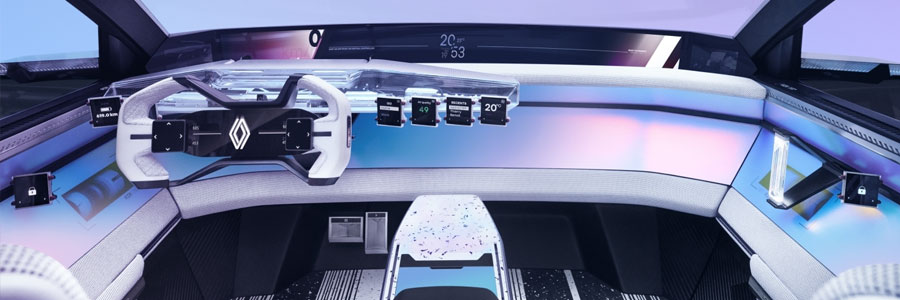Renault reinvents the Scenic

It's been more than 30 years ago since Renault invented the original Scenic, a new kind of family car that provided huge amounts of space and practicality. That was way back in 1991 when the first concept appeared, and as part of its strategy to develop an entirely electric range by 2030 the Scenic is returning.
The new Renault Scenic Vision is Renault's take on the future family car.
At 4.5m long the Scenic Vision features all the advantages of a family car: extended wheelbase, low belt line, large wheels, side and wheel-arch protective strips, and a horizontally aligned bonnet. It's also got a flashing Renault logo, touch-operated suicide doors, and clever flaps built into the 21 inch wheel rims that open and close according to your speed to improve aerodynamics and assist with brake cooling. There's even a special mechanism in the wheels that keeps the Renault logos in an upright position when the Scenic Vision is in motion.
If you're looking for a green mode of transport this might be it.
More than 70 per cent of the Scenic Vision is made with renewable and recyclable materials, and 95 per cent of the materials in its design – including the battery – are reusable, recoverable and/or recyclable. The 160kW electric motor derives directly from the All-New Renault Mégane E-Tech, while the 40kWh battery is lighter, smaller and costs less than a battery for a similar electric vehicle lighter, as well as being recyclable.
It also has a 15kW hydrogen fuel cell to recharge it during long drives and extend its range, which Renault says by 2030 and beyond, once the network of hydrogen stations is large enough, it will be possible to drive up to 500 miles, with the hydrogen tank able to be refilled in the same amount of time it takes to currently fill a tank with regular fuel.

The Renault Scenic Vision has been designed with the ultimate ambition of creating a car adapted to all, where accessibility, comfort, and safety are the most important features.
The suicide doors without a B-pillar make it easier to get in and out of the vehicle. There is no door lip to climb over, and lateral supports for the seats have been relocated to the inner door panel to allow even more room to climb aboard. A facial recognition device located on the outside of the vehicle, near where the two doors meet, is used to unlock the car, and automatically adapt the interior configuration (seat position, widget and app preferences, playlists etc) to the person it recognises, making for a truly tailored driving experience.
All the features of the Renault Scenic Vision can be found on configurable screens located throughout the interior. They are dedicated to different functions and a camera located in the front detects where people are looking and turns the screens to face the person seeking to interact with the system to make life easier. The cockpit's technological features are also interchangeable so regular upgrades can be made over the course of the car's life, without having to change car.
Clearly you're not going to get all of this in the 2024 version of this particular car. It is still a concept, albeit one that is actually rooted in reality. The Renault Scenic Vision is similar in concept to the work most of the big brands are doing to fully electrify their range of cars. There's a few hints of what might be coming in the next decade, but the basic concept of the practical and spacious family car will remain the same.
View our latest blog posts

Categories
Pages
We are a family run business based in rural Worcestershire. Our team of 38 staff are on hand to provide an exceptional service to personal and business customers.
Read More
